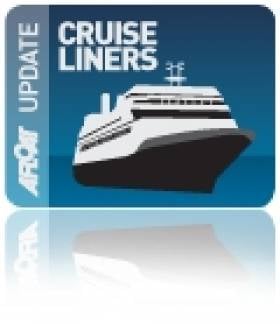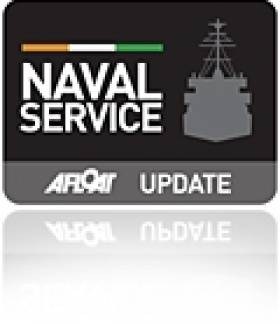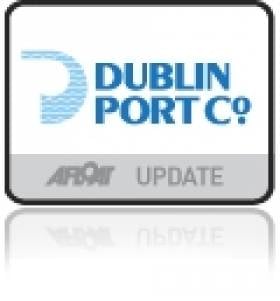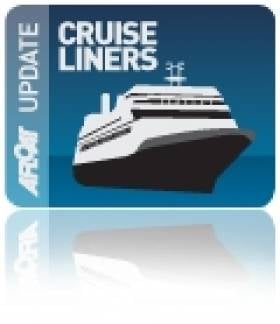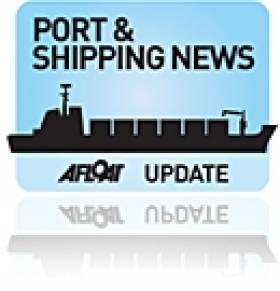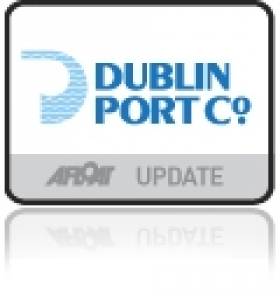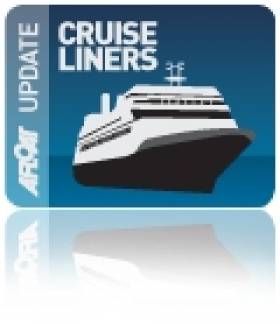Displaying items by tag: Dublin Port
New €1.5m Rail-Spur for Dublin Port
The minister welcomed "the important investment by Dublin Port Company in its rail network. It will further enhance the attractiveness of the port as a destination for rail-based freight. The project represents a commitment on the part of Dublin Port Company and Iarnród Éireann to customers who want to move goods by rail".
The project took six months to complete and the public private partnership involved Dublin Port Company, Iarnród Éireann and the first customer of the new facility, International Warehousing and Transport (IWT).
IWT is a privately owned Irish logistics company, which already operates freight-trains to Ballina that are expected to increase from 4 to 5 trains per week in each direction as a result of this investment. The rail-operator believes that the service will save up to 5.5million road kilometres annually and reduce CO2 emissions by up to 2,750 tonnes.
The Irish Exporters Association also welcomed the development of the IWT freight operation at the new facility, where increased frequency in services will enhance Ireland's contribution to the European Union's modal shift aspirations from road to rail.
The Common User Terminal is also open to other shipping companies. Existing clients using the lo-lo container terminal operated by Burke Shipping Group through its subsidiary Portroe Stevedores are C2C Lines, APL, Coastal Containers, Evergreen, Gracechurch and OOCL . The terminal also has a ro-ro berth facility where CLdN /Cobelfret operate from on routes to Belgium and The Netherlands.
In addition to the Dublin-Ballina service the port exports 400,000 tonnes of lead and zinc concentrate from the freight customers Boliden/Tara Mines with 15 trains per week. The facility at Alexandra Basin Jetty is regularly served by vessels from Arklow Shipping Ltd, where the 2011 newbuild Arklow Field (2,998 tonnes) is currently berthed.
- Dublin Port
- Dublin Port Company
- Arklow Shipping Ltd
- Irish Exporters Association
- Port of Dublin
- Ports and Shipping News
- IEA
- Minister for Transport
- Ocean Pier
- Irish Rail
- Iarnrod Eireann
- Portroe Stevedores
- Dublin Port news
- IWT
- ASL
- Leo Varadkar T.D.
- Port of Dublin news
- Railfreight
- International Warehousing and Transport
- Alexandra Basin East
- Common User Terminal
- Burke Shipping Group
- Clnd Cobelfret
- Boliden
- Tara Mines
- Arklow Field
- Dublin Shipping
- Lead mines
- Zinc mines
- Irish Railways
- Dublin Port railhead
Brand New Marina Calls to Dublin
The cruise started from Copenhagen and toured several ports in Norway from where the vessel continued to Lerwick, Torshavn,Iceland, Portree and her last port of call was Belfast. The vessel had berthed in Dublin's Alexandra Basin and departed this evening bound for Dover.
Following the Marina's departure out of Dublin Bay via the North Burford bouy, was the Marco Polo. The 1965 built vessel operates for Cruise and Maritime Voyages and she proceeded past the South Burford bouy bound for St. Mary's, the capital of the Scilly Isles.
There will be many more cruisecalls such as the ultra luxury six-star Silver Cloud which is due on Sunday. The 16,927 tonnes vessel operated by Italian owned SilverSeas Cruises, has only a capacity for 294 passengers. Following that visit P&O Cruises 115,000 tonnes Azura docks in the capital this day next week to disembark up to 3,500 passengers. To view a full list of cruise callers click HERE.
Largest Vessel Transits Samuel Beckett Swing-Bridge
She remained alongside this berth which is normally used by large commercial ships until the vessel sought a berth much closer to the city-centre. This led to a shift of berths in the evening when the 2003 built vessel headed upriver to the Dublin City Moorings facility at Custom House Quay, but this firstly required transiting through two bridges.
With a beam of 10.6m Fortunate Sun entered through the East-Link toll-lift bridge followed by the Samuel Beckett bridge, the Liffey's newest crossing point which opened in late 2009. The €60m bridge was commissioned by Dublin City Council and designed by the Spanish architect engineer Santiago Calatrava. To read more on the bridge click HERE.
Fortunate Sun is registered in the Caymen Islands and is capable of over 17 knots on a range of 5000 nautical miles. She has a steel hull and an aluminium superstructure and interiors also by Tim Heywood Design. In the early hours of tomorrow morning the vessel built by Oceanfast is to depart through the 5,700 tonnes bridge which was delivered by barge after a five-day voyage from Rotterdam.
There has been previous transits of the bridge notably the annual Dublin Rally organised by the the Inland Waterways Association of Ireland (IWAI). This year's Dublin Rally took place on 1 May when boats travelling on the Royal Canal descended via Croke Park and entered the Liffey at Spencer Dock. This required the Iarnrod Éireann bridge-lift and the water level in Spencer Dock to be lowered so to allow safe clearance under the Sheriff St. bridge.
From there the IWAI flotilla made the short passage downriver to re-enter another inland waterway system at the Grand Canal Dock, marking where the Liffey connects with the city's southern canal. The 2011 Dublin Rally was the first time since 1955 that boats could enter Dublin from the Shannon via the Royal Canal and the first time since 2004 that boats also joined from the Royal Canal.
- powerboats
- motorboats
- inland waterways
- Dublin Port
- Dublin
- Grand Canal
- IWAI
- Royal Canal
- DDDA
- Inland Waterways Association of Ireland
- Dublin City Council
- Spencer Dock
- River Liffey
- Ports and Shipping News
- EastLink Toll Bridge
- Dublin Port news
- Grand Canal Dock
- Dublin Docklands Development Authority
- M.Y. Fortunate Sun
- Tim Heywood Design
- Lifffey
- Dublin City Moorings
- Custom House Dock
- Powerboat news
- Motoryachts
- Sir John Rogerson Quay
- Inland Waterways news
- Dublin Rally
- Ianrod Eireann
- Oceanfast
- Scottish Western Isles
The operation was spearheaded by the ARW with the support of a Naval Service coastal patrol vessel (CPV) and also Air Corps helicopters. High-speed tactical assault craft with ARW teams on board conducted manoeuvres while air-borne teams fast-roped from helicopters onto the deck of the Stena Adventurer. To see photos of the ARW team in action click HERE.
The exercise was designed to enhance the capacity of the Defence Forces to provide the State with a highly specialised maritime armed intervention capability.
Last month the Naval Service conducted close quarter manoeuvres in 'Operation Quixote' off the south-west coast. The exercise involved the entire naval fleet except for the flagship LE Eithne, which performed in gunnery practice, simulated air attacks from the Air Corps and armed naval boarding parties.
RMR Shipping Increase Irish-West African Sailings
Dublin Port Company has welcomed RMR Shipping's new increased frequency of its service to West Africa, from a monthly to fortnightly service starting next month, writes Jehan Ashmore.
The direct service which began in 2009 using a single vessel from the capital to Nigeria, Ghana with calls to Lagos and Takoradi, is set to gain a second ship as demand for the service rises.
Two 157-trailer capacity ro-ro sisters are to be deployed on the route, they are the 23,000 gross tonnes sisters Celandine and Celestine. The Belgium-flagged pair both built in 2000 will take 18-days to transit between Dublin and Ghana.
The next sailing to Dublin is due on 5 July when the Celandine (PHOTO) is to dock at berth 51a, which is one of three berths located in the ports multi-user ferryport Terminal 1, shared by Irish Ferries, Stena Line and seasonal services of the Isle of Man Steam Packet Company.
Commenting on the development, Eamonn O'Reilly, Chief Executive Dublin Port Company said: "We are delighted with this development. Anything which increases the link between Ireland and emerging economies beyond Europe has got to be good for exports.
He added, "The service to Takoradi complements our involvement with Irish Aid from 2008 to 2010 in delivering an international training programme for ports in emerging countries including Ghana. The TrainForTrade programme was delivered with UNCTAD and we are hopeful of being able to announce a follow-up to the first programme in the coming months.
The development of RMR Shipping on the direct sea freight link was also welcomed by the Irish Exporters Association (IEA) whose chief executive John Whelan commented that exports to Nigeria last year exceeded €200m, the second largest market for Irish goods into Africa.
Spot the ‘Big’ Difference! From Containership to Cruiseship
It may just be another cruiseship visiting Dublin Port today, but the gleaming white painted Costa Marina started her career in complete constrast as a grey-hulled containership, writes Jehan Ashmore.
The cruiseship has some unusual hull design features indicating clues to her origins as the containership Axel Johnson (click PHOTO) notably the pronounced chine bow (horizontal-lines) still clearly visible under her name when launched in 1969 at the Oy Wärtsilä shipyard in Turku, Finland.
She was the leadship of five sisters of over 15,000 tonnes ordered by her Swedish owners, Johnson Line. The next sister completed, Annie Johnson was also converted into a cruiseship and she too serves Costa Cruises as their Costa Allegra.
Axel Johnson measured 174m in length and was fitted with two deck-mounted gantry-cranes to handle containers. Her design even catered for passengers but was limited to just four-persons compared to today near 800 passenger capacity and an increase in tonnage to 25,500. To see how she looks now click PHOTO
Her Scandinavian owners sold the vessel in 1986 though it was not until 1988 that the containership came into the ownership of her current owners Costa Cruises who converted the vessel at the Mariotti Shipyard in Genoa. Two years later the ship emerged as the Costa Marina (to see another click HERE).
She has nine decks which feature restaurants, bars, jacuzzis, pools, gym, treatment rooms, sauna, an outdoor jogging track, theatre, casino, disco and a squok club with PlayStation entertainment. Accommodation comprises for 383 cabins including 8 suites with private balcony and a crew close to 400.
Costa Cruises were founded in 1924 but they are a relative newcomer to Dublin. The vessel departs this evening from Ocean Pier bound for the Icelandic capital of Reykjavik. To view the ship's web-cam click HERE (noting to scroll right down the page).
Costa Marina and indeed larger cruiseships may in the future relocate upriver to berths much closer to the city-centre, should proposals by Dublin City Council take pace. In order to boost tourism numbers a dedicated new cruiseship terminal could be built at a site close to the O2 Arena and East-Link bridge.
The site at North Wall Quay Extension is currently in use by ferry operator P&O (Irish Sea) for their ro-ro route to Liverpool. To read more in a report in yesterday's Irish Times click HERE.
The Empire Strikes Back
The 14,620 dwt US-based training-ship Empire State made a return call to the Port of Cork last night for a four-day stay, writes Jehan Ashmore.
At over 172m long the cruiser-sterned vessel with a port of registry of New York, moored at the Cobh Cruise Terminal which was recently visited by another US training ship, State of Maine (click HERE).
The veteran vessel now in her sixth decade of service and is the also the sixth training-ship to carry the name 'Empire State' for the State University of New York (SUNY) Maritime College.
Empire State was laid down as SS Oregon at the Newport News Shipbuilding and Drydock Company, Newport News, Virginia. She was launched in 1961 for the States Steamship Company and delivered a year later for service in the Pacific trades. For further information about the vessel's interim career before she was converted for her current role click HERE.
Despite her conversion she still presents a distinctive profile with the superstructure positioned amidships between the cargo-holds.
Prior to the Empire State's arrival the French cruiseship Le Diamant departed Cobh for an overnight passage to Dublin, where last year the Empire State made a port of call.
The next cruise-caller to Cobh is the 296-passenger Silver Cloud which is scheduled to dock on Monday evening.
- Dublin Port
- Cobh
- Cork Harbour
- port of Cork
- New York
- Silver Cloud
- Cobh Cruise Terminal
- Cruiseships
- Cork Harbour News
- State of Maine
- Port of Cork News
- Training Ship
- Empire State
- Suny Maritime College
- La Diamant
- Newport News and Shipbuilding
- Newport News
- States Steamship Company
- State University of New York
Shackleton Spearhead's Into Dublin Bay
Lord Mayor of Dublin and Admiral of Dublin Port, Gerry Breen, performed the 523 year-old "Casting of the Spear" ceremony in Dublin Bay on midsummer's day, writes Jehan Ashmore.
The 'casting' for yesterdays' re-enactment by the Lord Mayor took place onboard the Dublin port Company tug Shackleton.
From the deck of the Spanish built 50-tonne bollard pull tractor-tug, a spear was launched into the sky and fell deep into the cold water's of Dublin Bay. The ceremony once again marked the position of the city boundaries eastwards.
The medieval tradition of 'Casting of the Spear' dates back to 1488 when the then Lord Mayor, Thomas Mayler, set out on his horse to ride the city's boundaries.
According to historical records he rode out onto the strand as far as a man might ride and from there he cast a spear into the sea. At that time, casting the spear demonstrated the extent of the city boundaries eastwards.
The tradition marks one of many significant moments in Dublin Port's long history since its establishment as a trading post some 1,200 years ago.
Floating City Hotel to Mark Start of Islands Cruise
Passengers embarking in Dublin Port for a cruise next month will firstly spend their first night onboard while docked in the capital, writes Jehan Ashmore.
The classic cruiseship Saga Ruby will welcome her passengers and after checking in they can explore the 4-star rated vessel followed by dinner, marking the first evening of an eight-night cruise of the Faroe, Orkney & Outer Hebridean Islands.
On the following day passengers can remain onboard and enjoy the facilities or take an optional tour of Dublin or Wicklow prior to returning to the cruiseship for the evening departure on 24 July.
Prices start from €1,159pp in a twin inside cabin, for more information on other cabin categories and the cruise from John Galligan Travel click here.
Saga Ruby is one of the last traditionally built cruiseships, featuring spacious wooden decks in particularly on the tiered decks overlooking her cruiser stern. The 24,492 tonnes vessel joined Saga Cruises in 2005 after a $17m refit and was at one stage was the Caronia of Cunard Line, but she started her career as Vistafjord for Norwegian America Line as a combined cruise-liner /cruise-ship when built in 1973. To read more about the classic ship click here.
She can take over 600 passengers and is currently operated by the Saga Cruises which caters primarily for the UK over-50's market noting passengers can be accompanied by adults over 40.
Former Soviet-Bloc Liner Continues Cruising
Cruising off the east coast of Leinster this evening is the veteran cruiseship Marco Polo which is bound for the Scilly Isles off Land's End, writes Jehan Ashmore.
For those with an appreciation for the more traditional tiered deck profile compared to the bulky new giant cruiseships, the 22,080 tonnes vessel built as the Aleksandr Puskin at the Mathias-Thesen-Werft, East Germany, certainly represents a different era.
The liner entered service in 1966 with the Baltic Shipping Company on their regular trans-Atlantic Montreal-Leningrad service. In 1975 she was converted for her new role as a full-time cruiseship. For a cut-away deck profile and description of facilities click here.
She can take 850 passengers accommodated in 450 cabins. Her main dimensions reflect her ocean-going design noting her draft is 8.2m (26.9ft) with a length of 176.3m (578.4ft) and a beam of 23.6m (77.4ft). Crewing is divided between senior officers (international) and cruise staff and entertainers are both British and comprising of other nationalities.
In recent years Marco Polo served the German market but she now is run by Cruise & Maritime Voyages (CMV) on cruises from the UK. The company also operate the Ocean Countess which first started out her days as Cunard Countess.



























